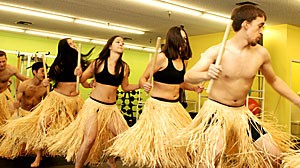The dance began with the rhythm of drums, a tambourine and a man chanting in Portuguese as dancers dressed in white clapped and formed a semi-circle.
A man played an instrument called a berimbau.
Two dancers jumped and kicked at each other, performing acrobatic twists as they “”fought.””
The moves are both aggressive and choreographed at the same time. Neither dancer touched the other.
The dance was part of Capoeira Mandinga Tucson’s grand opening Saturday, where member of the UA Capoeira Club performed the Brazilian dance.
Capoeira was created about 400 years ago, said Anne Pollack, instructor and founder of Capoeira Mandinga Tucson at Moore Training, 901 W. Prince Road.
The new school, which will begin classes in January, teaches the dance, which began as a mask for the martial arts training done by African slaves brought to Brazil, Pollack said.
“”They wanted a way to fight for what they wanted, but make it look like dance,”” she said. “”They didn’t want the slave owners to know they were training in a martial art for their freedom.””
Pollack said if slaves were given a Sunday off, they would dress in their best clothes, go to church and afterward, go and train as they danced.
The martial art was outlawed for many years in Brazil, though the Brazilian army used it during the 1864 war with Paraguay, Pollack said.
Saturday’s performances included a macuele, another type of Brazilian dance. The dancers wore dried grass skirts and played wooden dowels, which they struck in time with the drums’ rhythms.
Juan Ibarra, a communication senior and Pollack’s student, said he sees capoeira as an art form because it combines dance, acrobatics, interaction, music and the martial arts.
“”That’s what makes capoeira so unique,”” said Ibarra, who has been practicing capoeira for more than four years.
Another dance performance was a puxada de rede, which incorporated straw hats and a fishing net, complete with metallic “”fish.””
The dancers celebrated the act of moving a river boat with a pole and pulling in the catch.
Even now, the northeast coast of Brazil is still rich with fishing villages, Pollack said.
The puxada de rede and macuele are not capoeira, but they are kept alive by capoeiristas, or practitioners of the capoeira, she said.
One of Saturday’s capoeiristas, Nina Rao, a second-year creative writing graduate student, said the Capoeira Club on campus was part of her reasoning to come to the UA from Boston.
Rao attended capoeira classes taught by Pollack at the Student Recreation Center and said a good way to get to know the dance is to attend a class and watch.
The club meets twice a week during the semester and members often meet between semesters to keep up their training, Rao said.
“”We always like having new people,”” she said.
Capoeira was not made legal in Brazil until 1965, many years after a famous mestre, or master, of the art illegally opened a school to teach it, Pollack said.
After demonstrating the dance to the government, the mestre was given permission to teach it openly, she said.
Brazil now sees the positive effects of the dance in that it is fun and keeps children off the streets, she said. In Brazil, it is second in popularity only to soccer.









